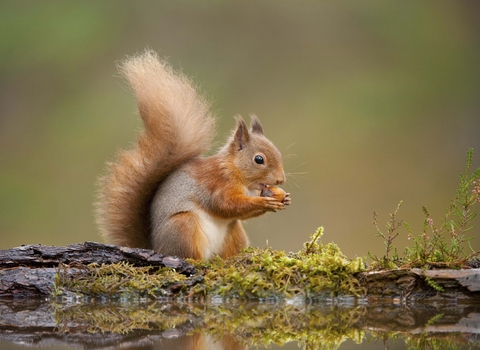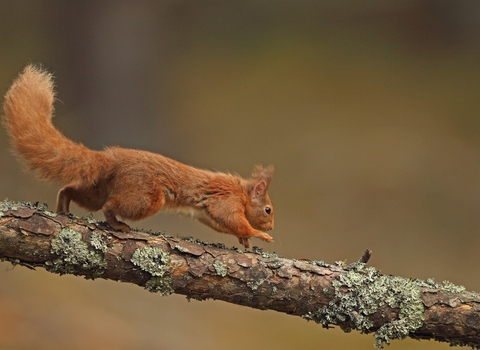
Red squirrel © Mark Hamblin/2020VISION
Red squirrel
Scientific name
Sciurus vulgarisWhen to see
January to DecemberSpecies information
Category
Statistics
Length: 18-24cmTail: 17-18cm
Weight: 100-350g
Average lifespan: 6 years
Habitats
About
Native red squirrels are a lot rarer in the UK than their American cousins, grey squirrels. Usually found in coniferous woodland, they like to feast on hazelnuts by cracking the shell in half. If you’re lucky you may also find pine cones that have been nibbled, leaving what looks like an apple core behind! Red squirrels make a rough nest called a ‘drey’ out of twigs, leaves and strips of bark high up in the tree canopy. Males can be seen chasing females through the trees, leaping across branches and spiralling up tree trunks.How to identify
The red squirrel has a reddish-brown coat and pale underside. It has a characteristically bushy tail. It is distinguished from the grey squirrel by its smaller size, red fur and distinctive, large ear tufts.Distribution
Found in Scotland, the Lake District and Northumberland; isolated, remnant populations further south in England and Wales, including Formby, Anglesey, Brownsea Island in Dorset, and the Isle of Wight.In our area
North Merseyside is home to one of the few urban red squirrel populations in England. They have been seen in two of our own reserves, Freshfield Dune Heath and Mere Sands Wood. Our Red Squirrel Project Officers, along with our volunteers, undertake regular monitoring, research and habitat management to ensure this small stronghold of red squirrels is protected, and the population can start to recover. It is our aim that red squirrels will once again become a common sight throughout North Merseyside, West Lancashire and beyond.
Did you know?
Red squirrels do not hibernate, but they do keep stores of food to see them through difficult times when fresh food is not available. In their favoured habitats of mixed broadleaf and coniferous woodland, they have a source of food all year-round as pine seeds are present over the winter months.Watch
Red Squirrel (https://vimeo.com/642268637)
John Bridges
North Merseyside is home to one of the few urban red squirrel populations in England. They have been seen in two of our own reserves, Freshfield Dune Heath and Mere Sands Wood. Our Red Squirrel Project Officers, along with our volunteers, undertake regular monitoring, research and habitat management to ensure this small stronghold of red squirrels is protected, and the population can start to recover. It is our aim that red squirrels will once again become a common sight throughout North Merseyside, West Lancashire and beyond.

Learn more about our red squirrel conservation work
Discover more about the red squirrel, the threats it faces, and the hard work that goes on to help protect this endangered species across our region and beyond.

Learn more about our red squirrel conservation work
Discover more about the red squirrel, the threats it faces, and the hard work that goes on to help protect this endangered species across our region and beyond.
